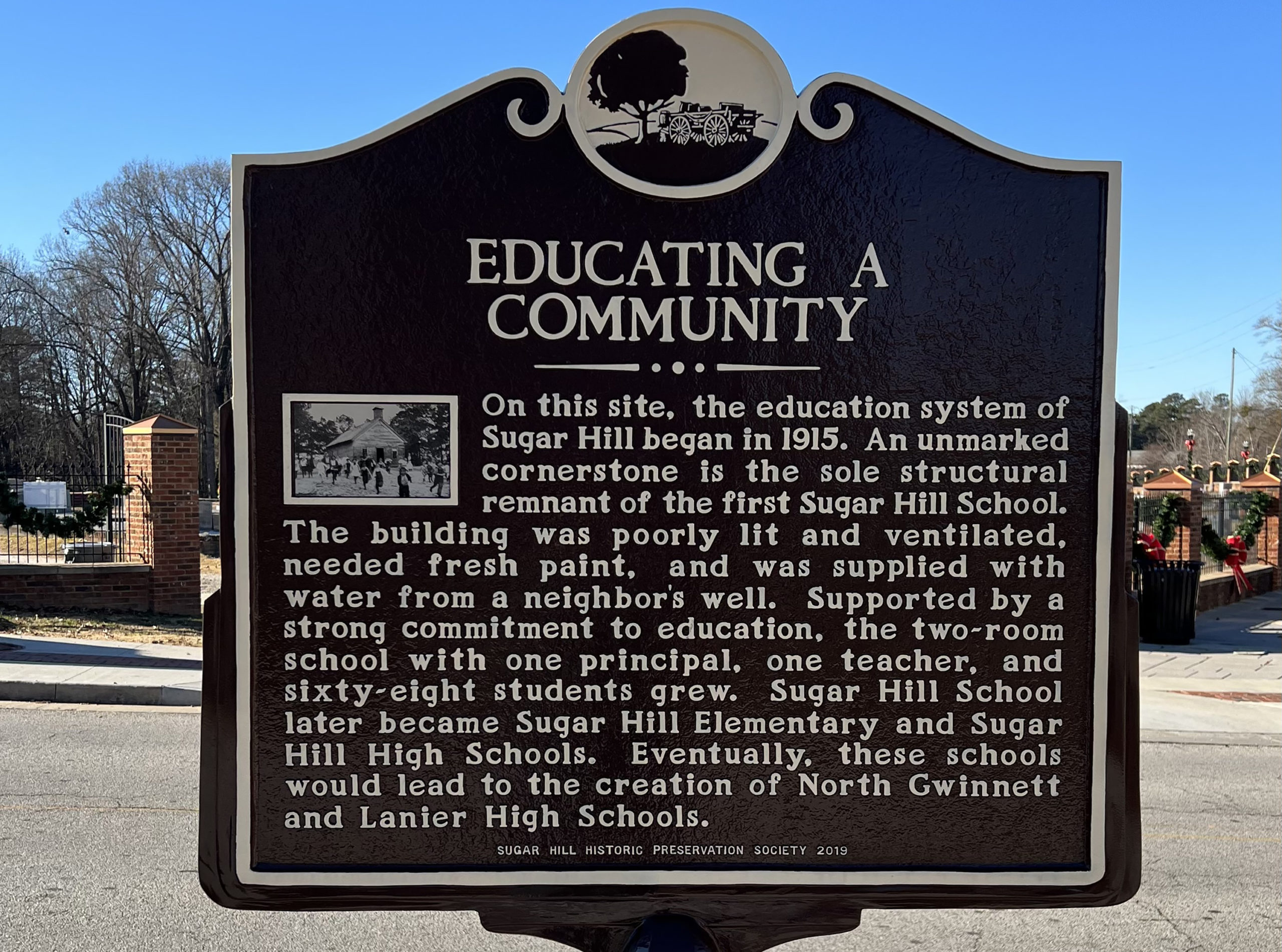Every day, we take a walk through our own history. In a sense, the direction we walk shapes our own past, present and future. Through that walk, we encounter people, places and events that shape our life and the lives of others. It is with this philosophy in mind that the Sugar Hill Historic Preservation Society has begun to install historical markers in the downtown area that highlight people, places or events that have helped create the community that we all love today. The historical markers are all within walking distance — strategically located to get individuals out of their cars for the purpose of exploring and interacting with the places and people of our modern-day community. Currently, the Society has placed four historical markers, with more installations planned in the future. The existing markers are designed to educate residents about our local government, the school system, the cemetery, the railroads and important people, places and events from our past.
 The first historical marker, located in front of Old City Hall, highlights one of our oldest buildings in Sugar Hill. Even though Sugar Hill was officially incorporated in 1939, our first official Sugar Hill Municipal Building was not dedicated until 1974. With a construction cost of $65,000, the facility included city offices, a jail and a precinct office for the Gwinnett County Police Department. The building served the needs of our community as a city hall until 2012. Today, Old City Hall — rebranded as the Suite Spot — provides an environment for small businesses to thrive and grow.
The first historical marker, located in front of Old City Hall, highlights one of our oldest buildings in Sugar Hill. Even though Sugar Hill was officially incorporated in 1939, our first official Sugar Hill Municipal Building was not dedicated until 1974. With a construction cost of $65,000, the facility included city offices, a jail and a precinct office for the Gwinnett County Police Department. The building served the needs of our community as a city hall until 2012. Today, Old City Hall — rebranded as the Suite Spot — provides an environment for small businesses to thrive and grow.
The second historical marker remembers the beginning of Sugar Hill’s education system in 1915. The first Sugar Hill School was located within what is now the Historic Sugar Hill Cemetery. The two-room school, served by one teacher, started with 68 students. All that remains of the school is a picture and an unmarked cornerstone, but the legacy of that rural school continues through both the North Gwinnett and Lanier clusters that serve the needs of students in our community.
The third historical marker, located near the new Veterans Memorial, recognizes the significance of our community’s main burial ground — Historic Sugar Hill Cemetery. An early investment by Sugar Hill’s founding families in the 1880s, it is the final resting place for individuals who have a left a mark on our community for nearly 130 years. The cemetery is now the backdrop for the Veterans Memorial, which is dedicated to the nearly 150 service members buried in its hallowed grounds.
The fourth historical marker, installed on Alton Tucker Boulevard near Peachtree Industrial Boulevard, commemorates the triumphs and tragedies associated with the railroad line that goes through Sugar Hill. In 1908, a tragic train wreck occurred at Mangum’s Crossing. Carrying a combination of troops and freight, only two individuals lost their lives in the wreck — Benjamin Dewberry, the train engineer, and his assistant, Mayson Wadkins. A 12-year-old, Louis Cooksie, was accused of placing a bolt on the tracks and causing the train wreck. Throughout the history of the railroads in our community, trains would continue to bring both tragedy and hope. Sugar Hill missed the opportunity for a train depot, but we benefited from the trade and commerce associated with Buford’s train depot.
An additional historical marker, planned for installation in 2022, will bring attention to Sugar Hill’s Champion Southern Red Oak Tree. The tree has a 17-foot circumference and could be as old as 190 years of age. Recently, Sugar Hill’s Youth Council visited the tree, and it is amazing to think about the age difference between the tree and the youth of our community. The oak almost predates Gwinnett County and certainly the removal of the Creek and Cherokee Indians from the area that settled along the Chattahoochee River. As a seedling, it would have been in what was considered the wilderness on the very edge of civilization.
When I was young, my grandparents on the Hembree side of the family lived in the mill community of Scottdale. My grandfather and I would walk in the evenings and talk to neighbors who enjoyed their front porches in the warmer months of the year. We would talk about all the eventful happenings in the Scottdale community — the births, the deaths, the celebrations, the tragedies and everything that makes a life fully lived. I also learned about history and why history is so important, and I discovered a lot about community. Someday soon, I hope you will take a walk and visit the historical markers in Sugar Hill’s downtown area and that you will stop and talk to your neighbors along the way. The best history is the history we walk and experience together as a community.
Brandon Hembree serves as mayor of Sugar Hill. He is a 20-year resident of the city, and he uses his interest in history to detail Sugar Hill’s rich past.




